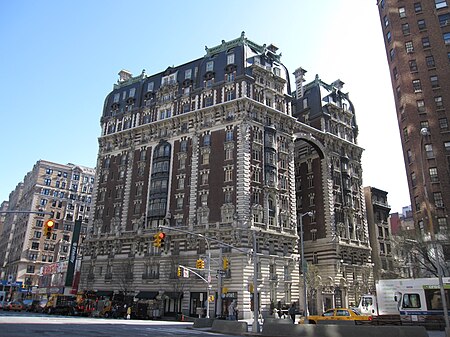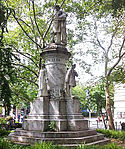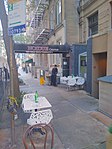The Apple Bank Building, also known as the Central Savings Bank Building and 2100 Broadway, is a bank building and residential condominium at 2100–2114 Broadway on the Upper West Side of Manhattan in New York City. Constructed as a branch of the Central Savings Bank (now Apple Bank for Savings) from 1926 to 1928, it occupies a trapezoidal city block bounded by 73rd Street to the south, Amsterdam Avenue to the east, 74th Street to the north, and Broadway to the west. The Apple Bank Building was designed by York and Sawyer and patterned after an Italian Renaissance-style palazzo.
The exterior consists of a base of rusticated stone blocks. Above the first floor, there are double-height arches on all four sides with ornamental ironwork by Samuel Yellin. The fifth and sixth stories are treated like a loggia, with windows separated by pilasters, while the roof is made of Spanish tile. Inside, entrances on 73rd Street, Broadway, and 74th Street lead to ornamental vestibules. The rectangular banking room next to Amsterdam Avenue has sandstone walls, a marble floor, large niches, and a coffered, barrel-vaulted ceiling. A mezzanine overlooks the banking room to the west. The building's basement, formerly a bank vault, serves as a gym. The upper stories contain 29 apartments.
The Central Savings Bank Building opened on December 8, 1928, as an uptown branch of the bank, which at the time was headquartered in Union Square, Manhattan. The upper floors were originally rented out as offices, while the bank occupied the ground floor. The building's facade was made a New York City designated landmark in 1975, and the building was added to the National Register of Historic Places in 1983. The Central Savings Bank merged with the Harlem Savings Bank (later the Apple Bank for Savings) in 1981, and the building continued to operate as a neighborhood bank branch. The banking room was designated as a New York City landmark in 1993. The upper-story offices were converted into apartments from 2004 to 2007. Contrary to other large bank buildings in New York City, the Apple Bank Building still contains a bank branch.










